The Kizer Minitherium is a very different knife from the rest when you look at it. It was released in 2020 as an upgraded and miniature version of Kizer Megatherium.
It’s about 1.5” shorter than the original in overall length, weighs half the original’s weight and is $40 cheaper. The unique design is by Late Elijah Isham as well as the original, and manufactured in China like the rest of Kizer knives. It falls under the mid-tier folding category of knives.
Please Note: Kizer Megatherium is borrowed from a friend for this review purpose for few days.

Kizer Minitherium Review
Kizer Minitherium is a mid-tier folder because it extends up to 7.10” with a 3” blade length and 4.10” handle length. It comes with Spyderco inspired thumb-hole for deployment as well as a flipper. The Kizer Cormorant also had these two deployments. However, this one comes with a liner lock rather than a button lock. It has the same CPM S35VN high-end premium steel blade with carbon fiber as its handle material and weighs only 2.96 ounces.
Key Specifications of Kizer Minitherium
Blade of Kizer Minitherium
The blade of Kizer Minitherium is quite unique and unsynchronized with the handle. It is broad and rounded against a handle with sharp curves and peaks. It has a modified Wharncliffe blade shape that curves towards a sharpened edge. The blade’s spine has a long rounded plunge towards the tip with a false swedge that transitions into a concave thumb ramp towards the top.
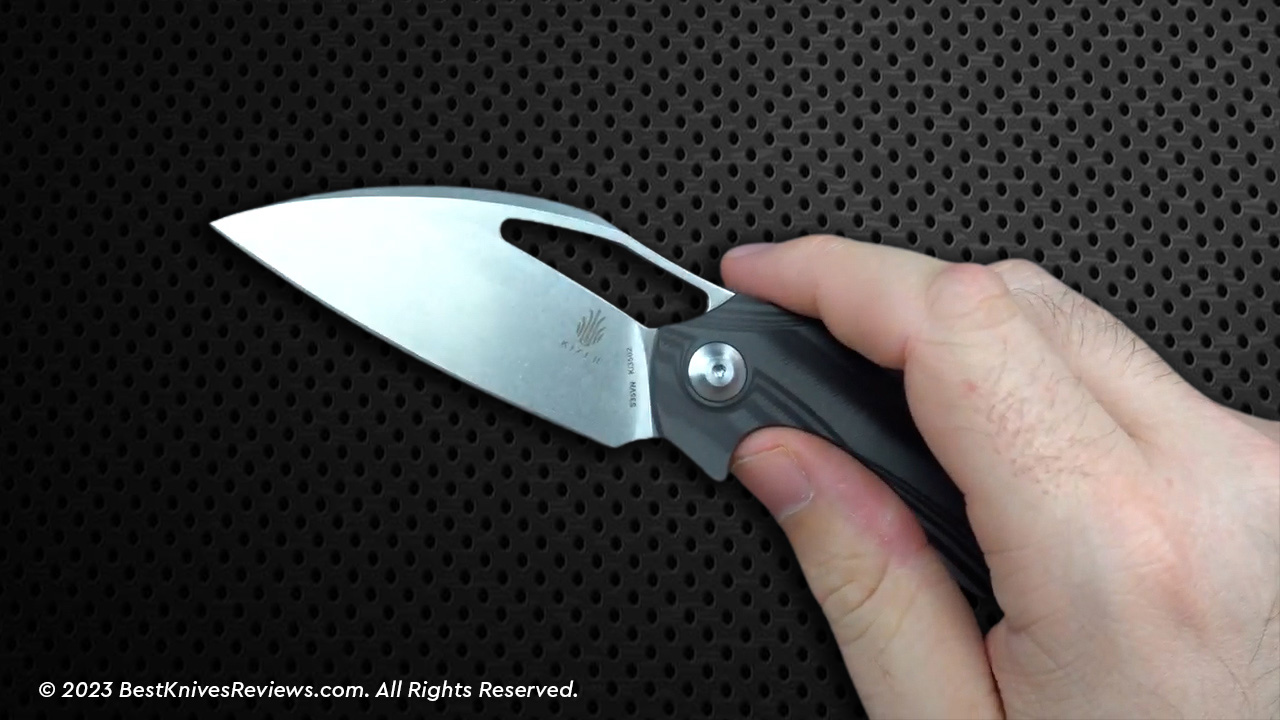
The blade stock thickness remains reasonable at 0.12”, quite common for EDC knives. It has a tall flat grind at the primary bevel that runs parallel with the oblong of the bottom of thumb hole before transitioning into a diagonal plunge line. It then cuts parallel to the leading edge of the handle. This is also where you see the knife’s marking, with Kizer logo, model number and steel material on show side, and the designer’s name, Isham’s logo and name of the knife at the lock side. It makes the branding much more subtle without hanging a billboard on it.
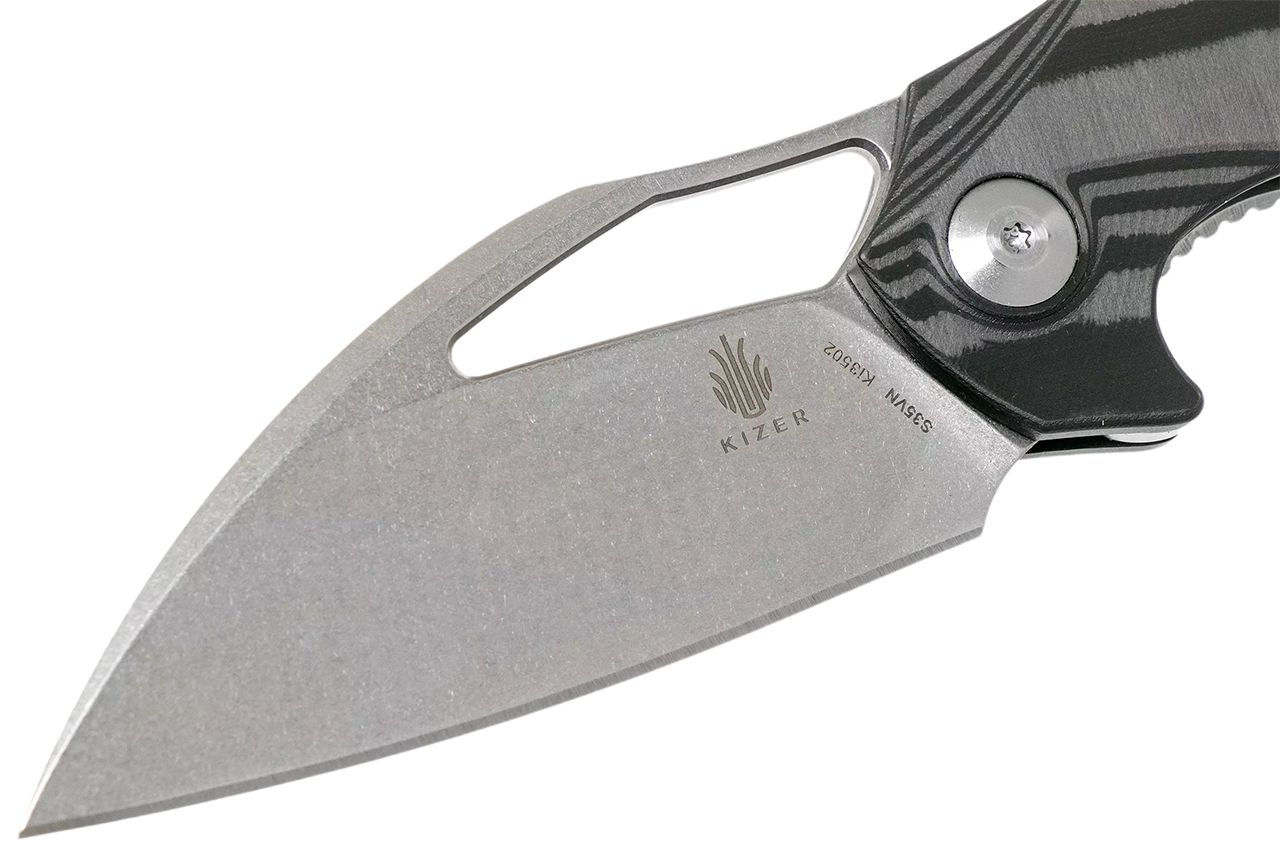
The 3” blade length is ideal to carry within Chicago and the States, where the acceptable length of an EDC carry knife is 3”. It also makes the knife manageable.
The blade material is the premium CPM S35VN like most Kizer models like the Kizer Cormorant, Kizer Guru, Feist, Gemini, Begleiter and Yorkie – all that fall above the Vanguard Line. The S35VN is also an excellent choice because it was designed specifically for cutlery EDC knives by Chris Reeves Knives. It was an updated version of S30V with more niobium. Its chemical composition makes it easier to sharpen, corrosion resistant, tougher and adds edge retention. The stonewash finish further helps with the non-corrosive properties of the blade. However, the blade lacks factory edge, but the edge bevel is clean and leveled.
Handle of Kizer Minitherium
The carbon fiber scales cuts away in flowing shapes to contour the handle. It even shows the material grain varying in different sizes and shapes due to the fine finishing. The carbon fiber refers to the thin strands of carbon tightly woven together and then set in resin. It is carbon fiber reinforced polymer that results in strong yet lightweight material but a bit expensive.
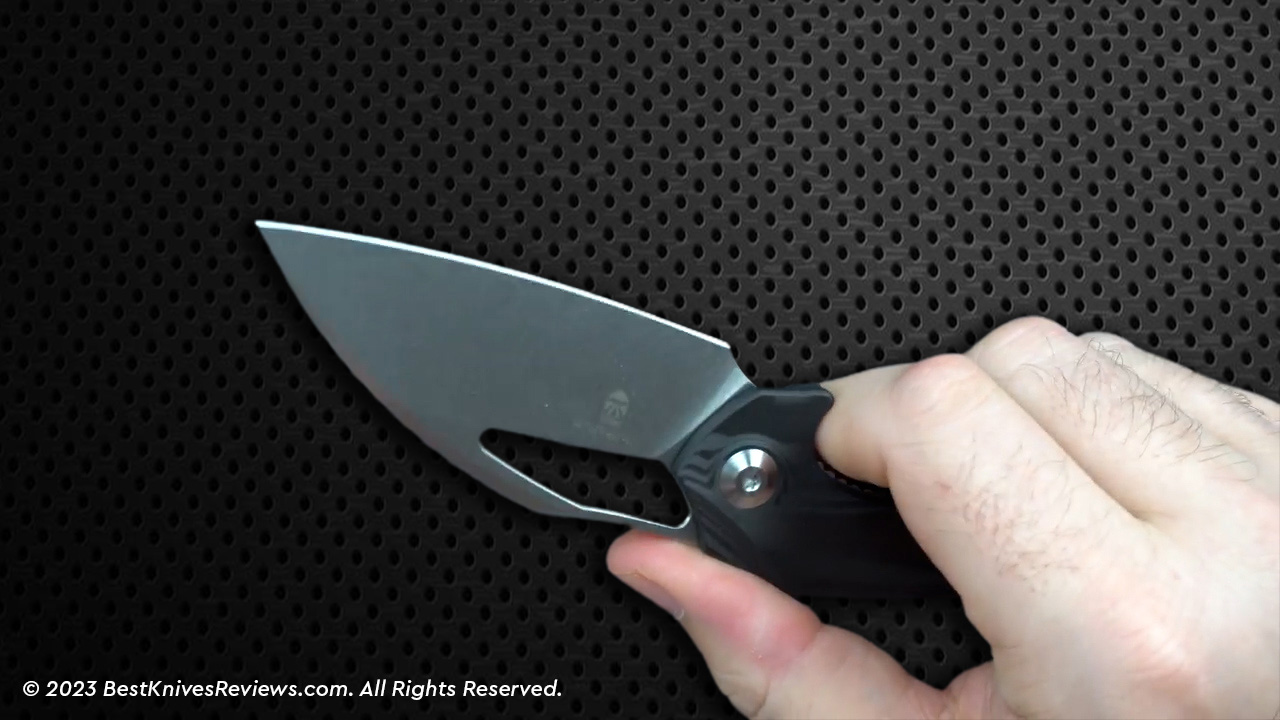
However, it can get brittle over time if stretched in its wovened opposite direction. That is why some knife manufacturers like the Kizer sometimes add the G10 laminate. But Minitherium does not have that. It is smooth and not over-epoxied, offering some built-in grip.
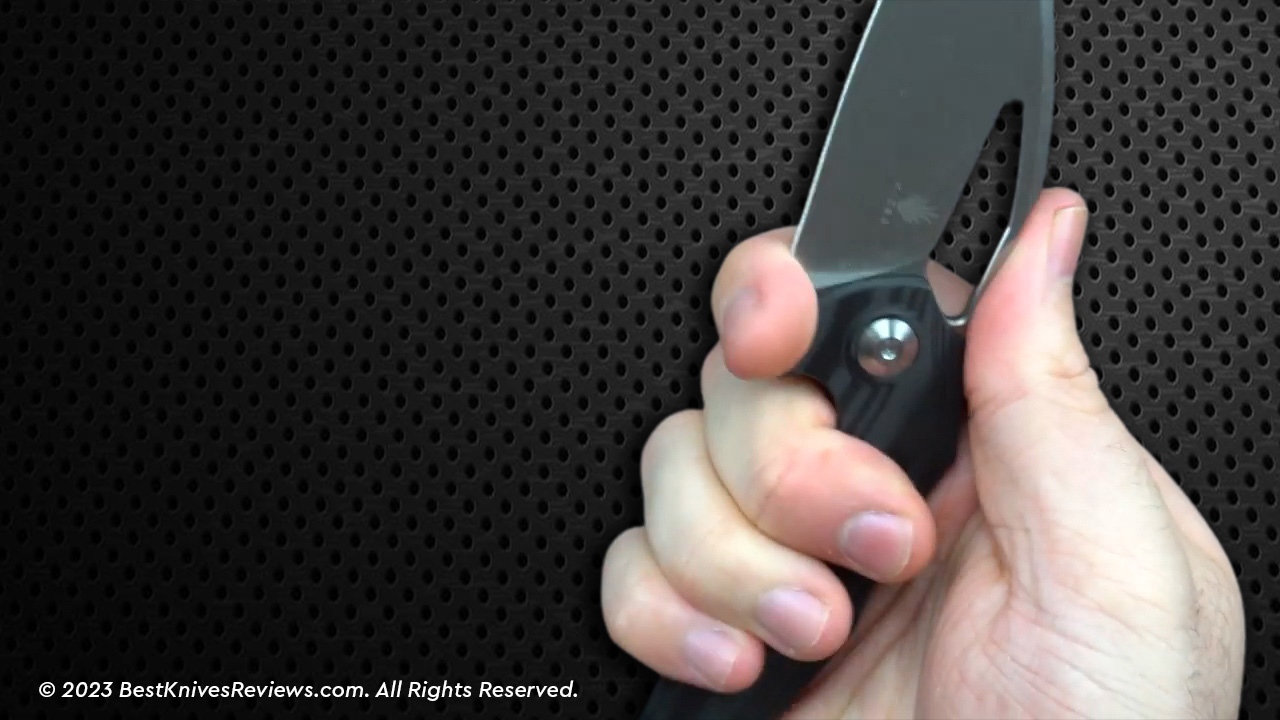
This makes the knife ergonomically friendly. It provides a firm grip regardless of the sweats or oils on your hands. It is equally grippy when handled while wearing gloves.
The handle construction is quite hand-friendly. The curved edges makes it easy to hold the knife and cut while placing it on the cutting board. The swedge would prevent your knuckles from banging into the cutting board when chopping vegetables and fruits.
The Minitherium has skeletonized stainless steel liners on the show side of the handle to balance out the knife’s weight. The blade fits perfectly perpendicular inside the scales and does not coincide or waver elsewhere.
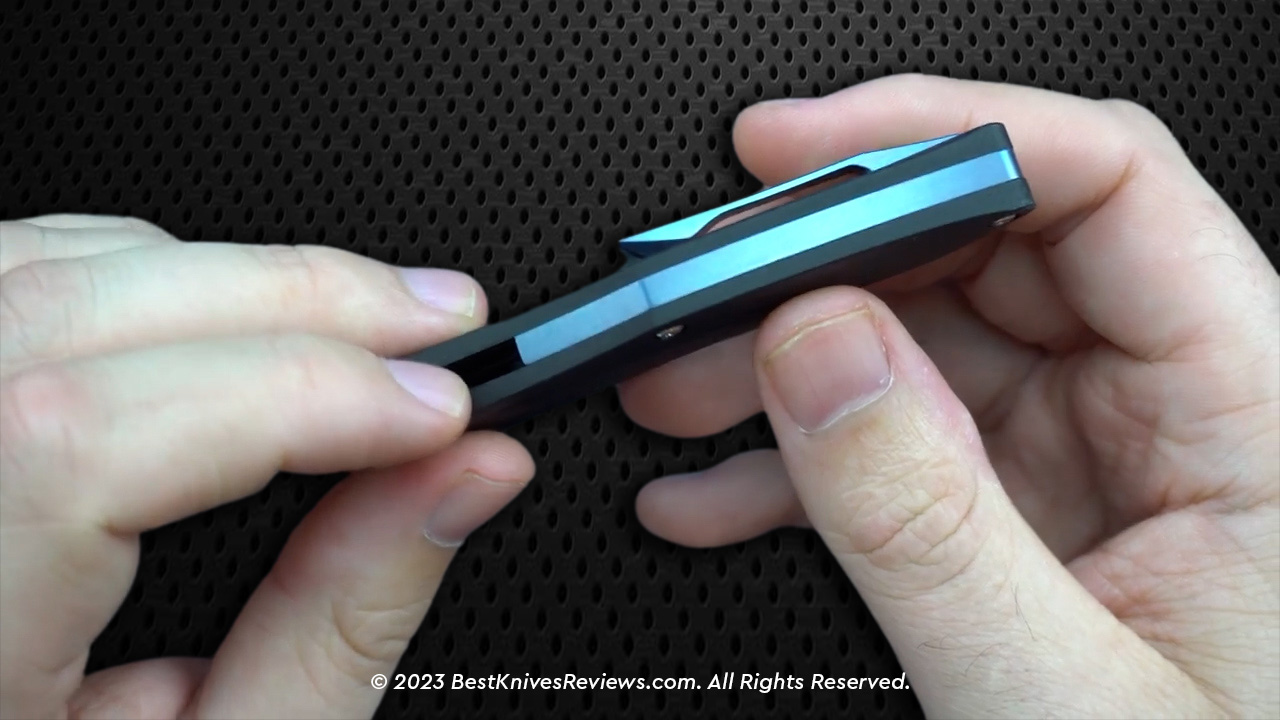
The pivot hardware is well-designed where it is less goofy and less prone to stripping out when loosenign it. The machined titanium pocket clip is tip-up carry with flush fitting machined backspacer. They are both light blue anodized to provide some contrast, making it visually appealing. The anodization makes it look attractive, but wears out rapidly. The fitment on the backspacer is also not as flush as it is on the top end. But that does not impact functionality.
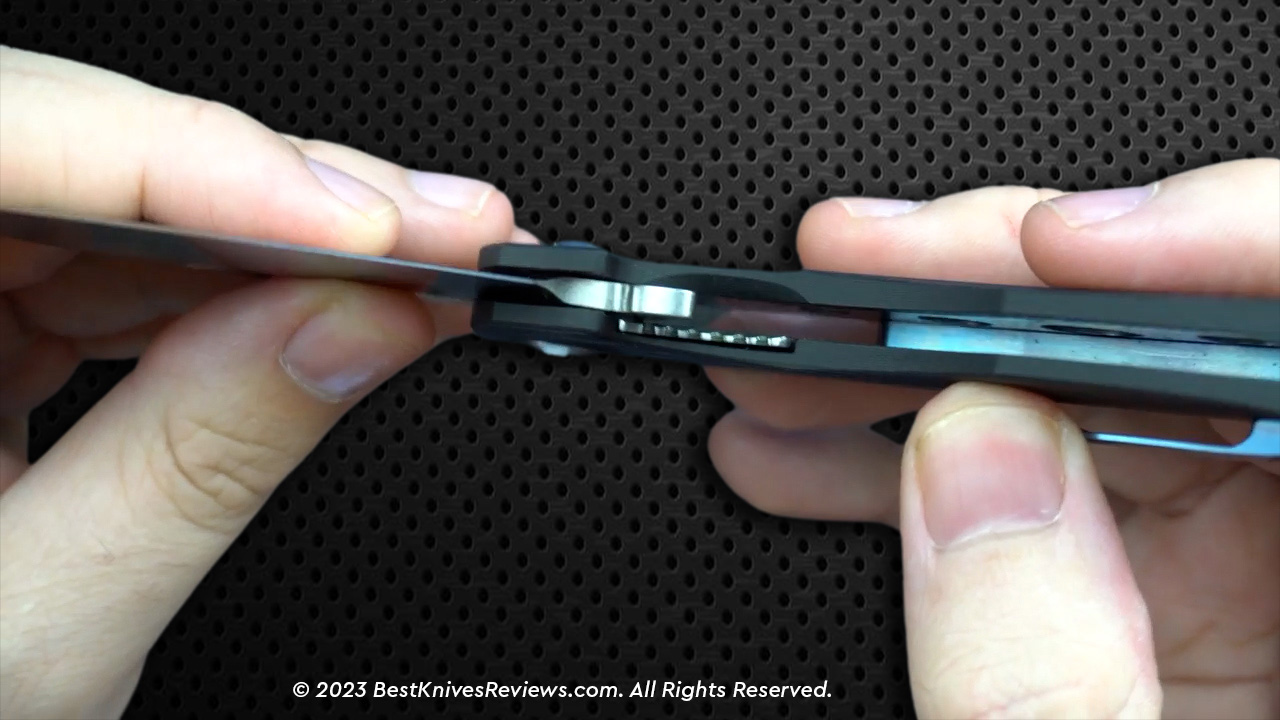
The pivot hardware is well-designed where it is less goofy and less prone to stripping out when loosenign it. The machined titanium pocket clip is tip-up carry with flush fitting machined backspacer. They are both light blue anodized to provide some contrast, making it visually appealing. The anodization makes it look attractive, but wears out rapidly. The fitment on the backspacer is also not as flush as it is on the top end. But that does not impact functionality.
The pivot is a Chicago-style screw with a tube on one end and screw on the other. It is not keyed towards the frame, so you would have to hold it with one bit driver while turning on the other side when disassembling and maintaining it. Both the pivot screws are Torx T8, the 4 body screws and 2 clip screws are Torx T6. These are pretty standard so you do not need any propriety tools to unscrew them.
Deployment & Lockup of Kizer Minitherium
The Minitherium comes with Elijah Isham’s Edge below Tab flipper system that conceals the flipper in an open position for unobstructed performance. It places the flipper tab below and forward in a closed position. The handle cuts away for access and places tab in the handle out of the way when opened. The tab placement is strategic in a way that it does not protrude out from the handle when in use. It is a good functional feature for deployment.
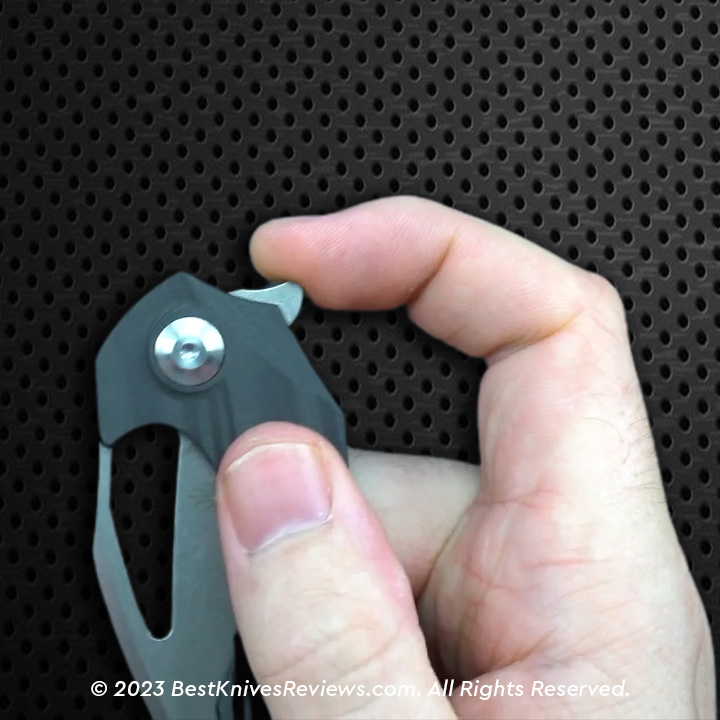
Just like the Kizer Cormorant and Theta, the Minitherium flips on caged ceramic ball bearings on special shaped steel washers. The washers fit between the bearings and carbon fiber to prevent wear. Although ceramic bearings on carbon fiber can wear out quickly. However, the action is done much better on Mintherium than it was on Theta, although both have fairly light detents. But the Minitherium has less drag from the detent when using the flipper like a push button, opening the knife much more reliably.
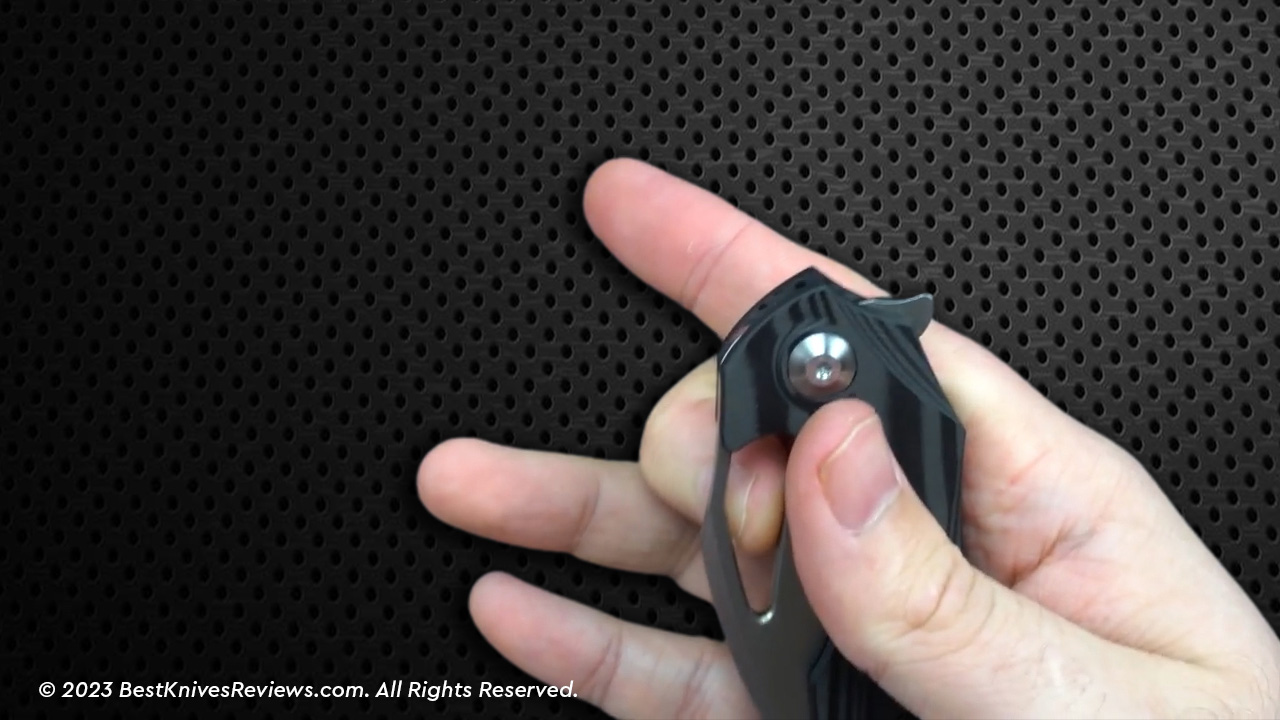
The knife has an exceptionally large and narrow thumb-hole that is difficult to use from both the sides. The finger choil obstructs your thumb from moving forward from the front and gets in the way of the middle finger when approached from the rear end. But the light detent makes it easier to open from either side. It is also better to slide your finger towards the upper end of the thumb hole when disengaging the blade. It is kind of like opening a door; however far end you open it the less effort it requires.
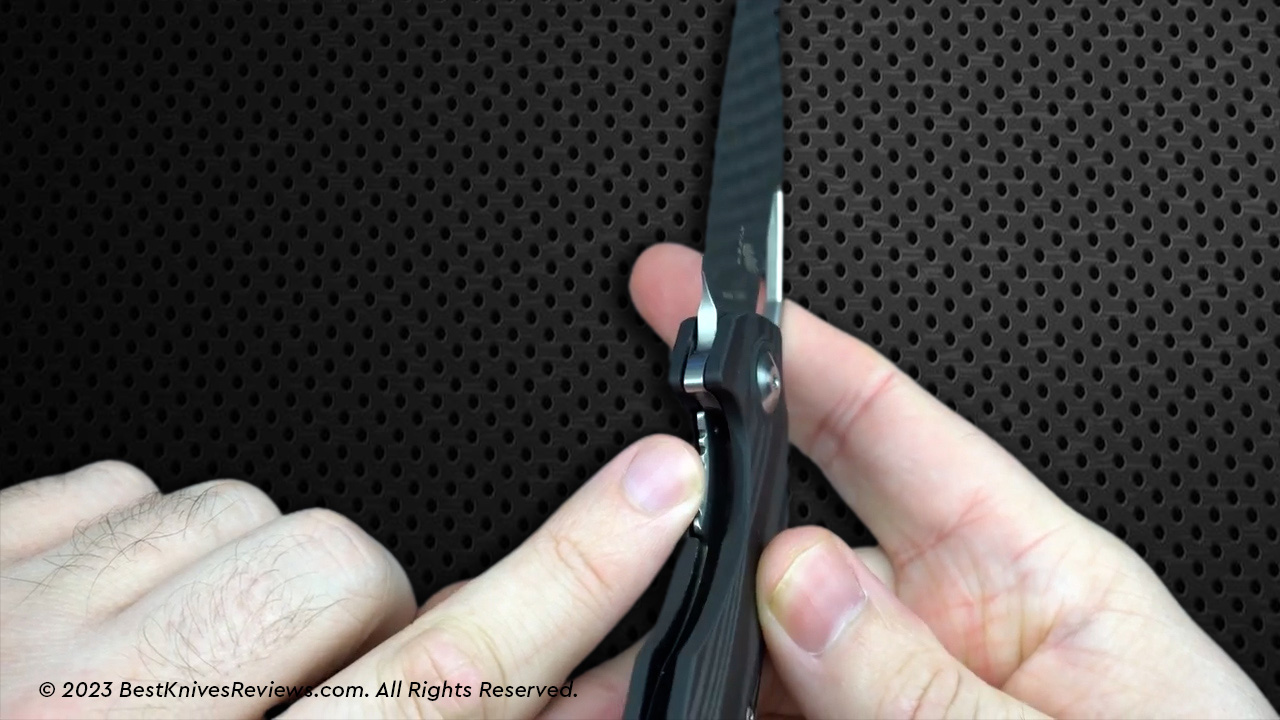
The lockup is a simple stainless steel liner lock, thin and effective. It engages at the far end of the blade tang easily, leaving no vertical or horizontal blade play. The lock also works pretty well. It has enough jimping for traction and the section opposite the liner lock on show side cuts away slightly to provide enough room to disengage the blade.
Deployment and lockup are both pretty solid on the Kizer Minitherium.
Field Test of Kizer Minitherium
The first thing we noticed before testing Kizer Minitherium is how well it carries in your pocket. It is lightweight, discreet and does not tarnish easily. The knife profile is such that it hangs well in the pocket made out of any fabric and takes less space. You can slide up your cell phone and keys along with it. It has a broad profile behind the pivot but the forward-mounted flipper tab minimizes that to a certain extent. The machined titanium clip was definitely a smart choice.
However, the tip of the pocket clip is sharp and pointy, especially when you are closing the knife. But the good news is that you can smooth out the sharp edges by using a sandpaper or a fine grit file to rub against it. The downside of it is that it will mess up the fine anodization.
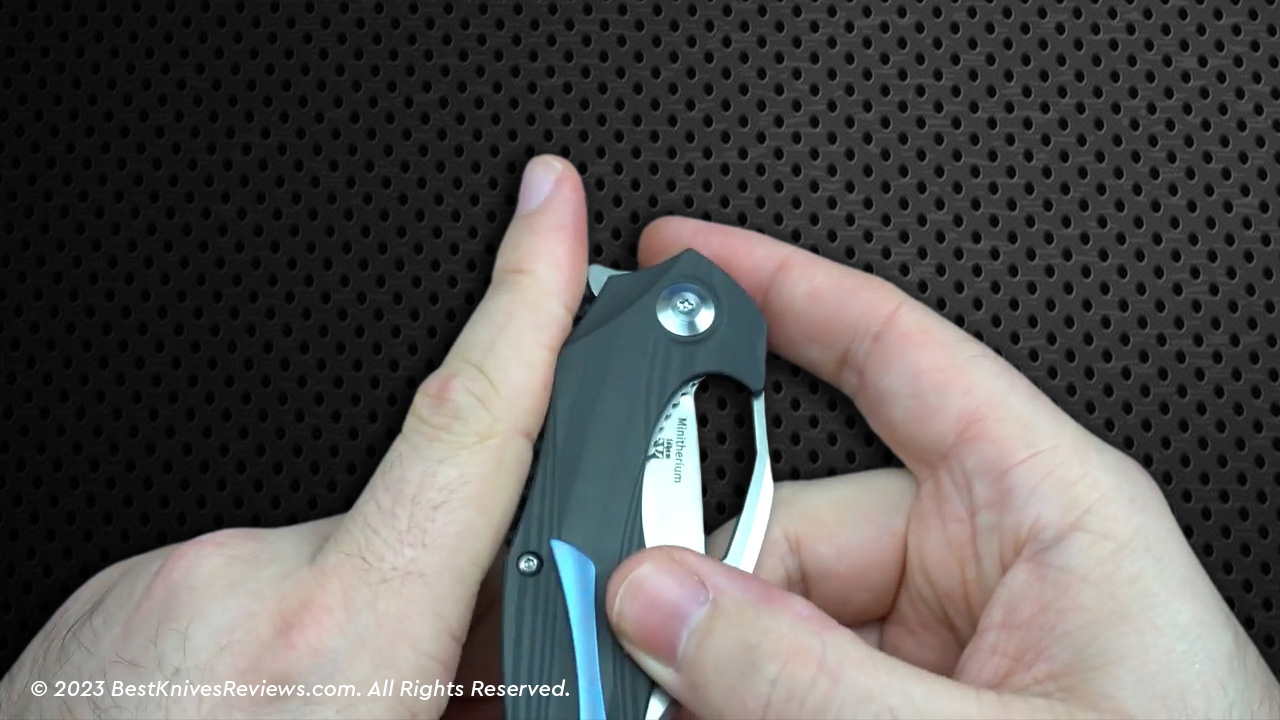
It works well either way. The edge of the blade also does a great job in punching through tough packaging material like cardboard and layers of bubble wrap. The Wharncliffe blade comes into handy here with its ‘edge below tab’ design. It keeps your finger out of the way when using it. I cut my thumb twice while using Kizer Mini Sheepdog knife earlier for same reasons.
The knife geometry works as well as an EDC, and it is more like an expensive box cutter, but does its job well. It is reminiscent of a utility knife. You can also really choke it up using the finger choil and cut open cardboard boxes, envelopes, and other stuff around the house and office. The forward-curving blade carves the way for holding the knife from the front, back and center. It is pretty flexible.

It is also easy to maintain the Minitherium. But it does require three arms to unscrew the pivot and backspacer screws with two bit drives at once. So you may need someone else’s help to do that. If not maintained regularly however, you may witness some grit buildup in the bearing cartridges. But it can be cured with compressed air and oil. It is also easy to sharpen and smooth out the edges.
Comparisons
Kizer Minitherium vs Kizer Theta
As you can see, the Kizer Theta looks much like Kizer Minitherium, except that it is fully titanium and has a straighter profile. But Minitherium has better ergonomics with its lightweight carbon fiber scales and curved handle. Both the knives have the same blade, but the Minitherium offers superior cutting performance with its finer blade construction and edge holding.
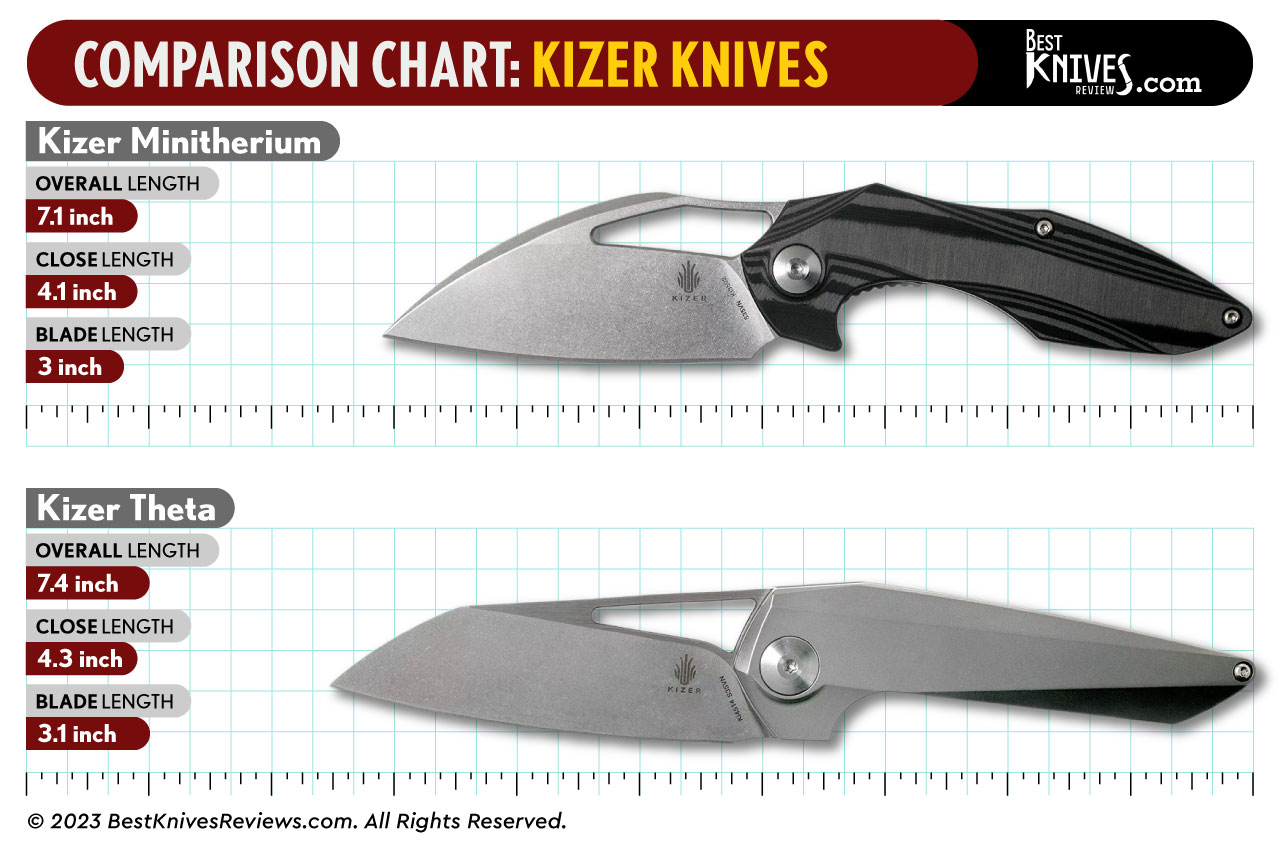
Theta’s thumb-hole works just as well as the Mintherium with a perfectly aligned blade. Its price is also the same as Minitherium, but the Miitherium is a clear winner when it comes to functionality and features.
Kizer Minitherium vs Zero Tolerance 0456CF
Minitherium and ZT 0456CF both have carbon fiber handles and a chunky profile. But ZT 0456CF is lightweight, down 1.7 ounces as compared to Minitherium with a 3.25” Sheepsfoot blade in CPM 20CV premium quality steel.
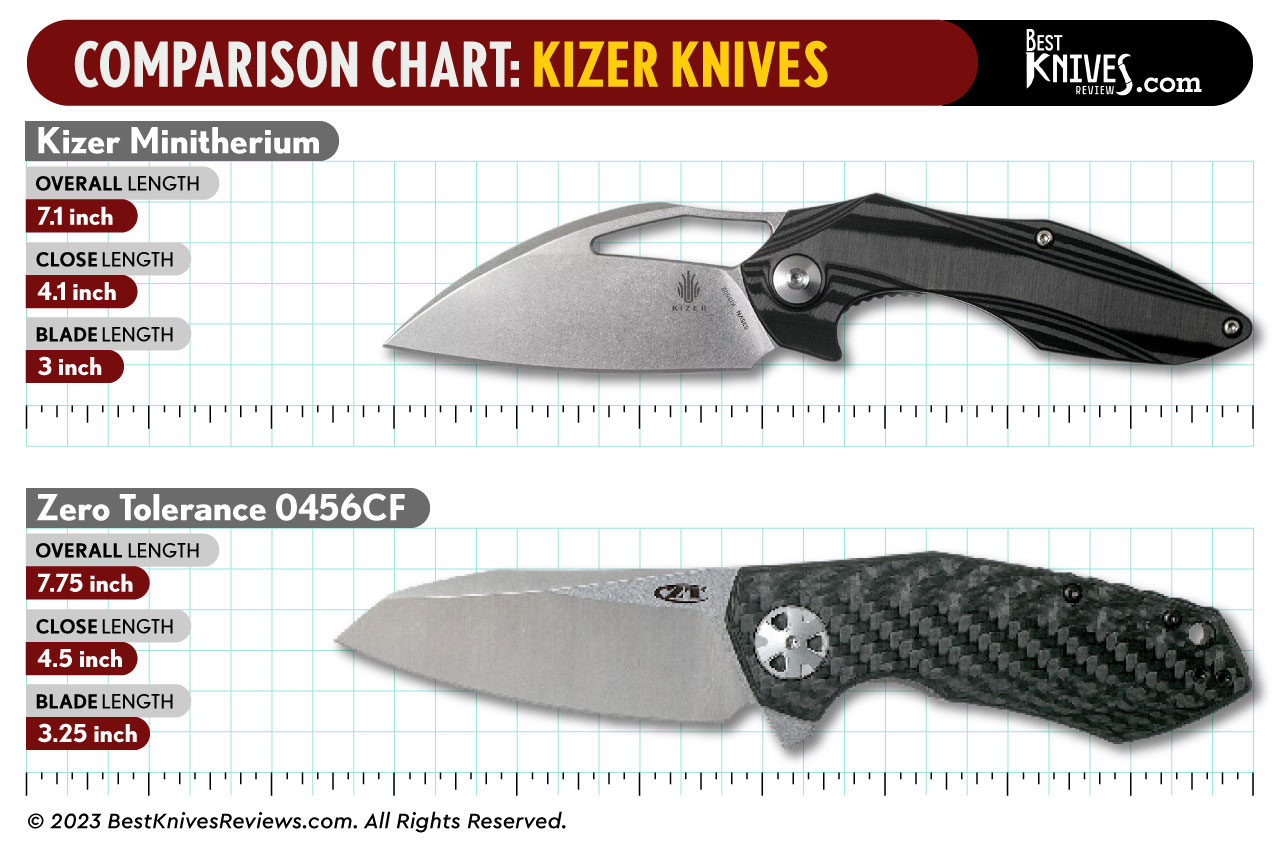
It is also stonewashed but with titanium lock side scale and a funky decorative pivot instead of an anodized Minitherium’s pivot. But it is more expensive than the Minitherium. Both the knives are good though and perform equally well.
Conclusion: Kizer Minitherium Review
Overall, In Kizer Minitherium review, most of the objective elements turn out to be quite positive, given its materials, construction, aesthetics, design and functionality.
However, we have had a better experience with Kizer knives before. Although it is uniquely shaped, the 3” blade length makes it accessible to carry anywhere.
The ergonomics of the knife are also on-point with lightweight carbon fiber scales and a nice tip-up pocket clip. It holds well in the pocket, is discreet and lightweight with a stonewash finish.

The deployment and lockup are equally good. However, the thumb-hole can get awkward. The liner lock is simple, easy to unscrew and maintain. But you may need another person to help you unscrew it.
We did find the price a bit more expensive relative to its performance, but it performed well in the field with the basic EDC tasks like cutting open packages. So if you want a small discreet knife with a premium blade and lightweight scales, then Minitherium is a good choice.
Pros & Cons of Kizer Minitherium
